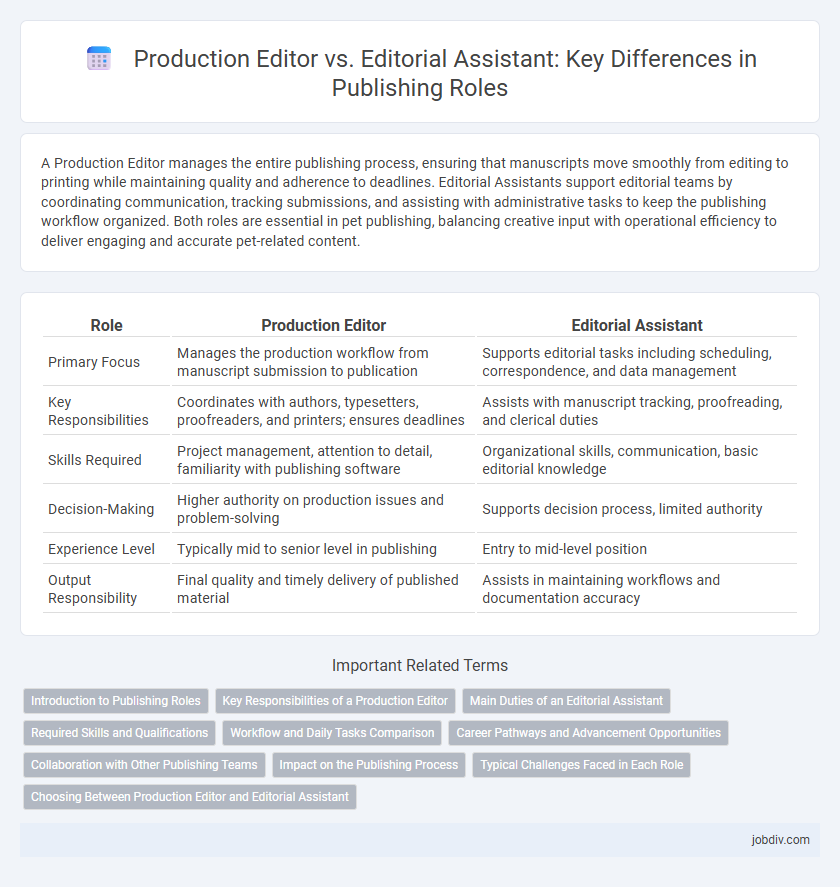A Production Editor manages the entire publishing process, ensuring that manuscripts move smoothly from editing to printing while maintaining quality and adherence to deadlines. Editorial Assistants support editorial teams by coordinating communication, tracking submissions, and assisting with administrative tasks to keep the publishing workflow organized. Both roles are essential in pet publishing, balancing creative input with operational efficiency to deliver engaging and accurate pet-related content.
Table of Comparison
| Role | Production Editor | Editorial Assistant |
|---|---|---|
| Primary Focus | Manages the production workflow from manuscript submission to publication | Supports editorial tasks including scheduling, correspondence, and data management |
| Key Responsibilities | Coordinates with authors, typesetters, proofreaders, and printers; ensures deadlines | Assists with manuscript tracking, proofreading, and clerical duties |
| Skills Required | Project management, attention to detail, familiarity with publishing software | Organizational skills, communication, basic editorial knowledge |
| Decision-Making | Higher authority on production issues and problem-solving | Supports decision process, limited authority |
| Experience Level | Typically mid to senior level in publishing | Entry to mid-level position |
| Output Responsibility | Final quality and timely delivery of published material | Assists in maintaining workflows and documentation accuracy |
Introduction to Publishing Roles
A Production Editor manages the workflow of book or journal production, coordinating with authors, designers, and printers to ensure timely completion and quality control. An Editorial Assistant supports editors by handling administrative tasks such as manuscript tracking, correspondence, and fact-checking to maintain the editorial schedule. Both roles are essential in publishing, with the Production Editor focusing on the logistical elements and the Editorial Assistant on editorial support and organization.
Key Responsibilities of a Production Editor
A Production Editor manages the entire publication process, coordinating between authors, editors, and designers to ensure timely delivery of high-quality content. They oversee copyediting, typesetting, and layout, maintaining strict adherence to style guides and publishing standards. Their role includes project management, quality control, and ensuring that production schedules align with publishing deadlines.
Main Duties of an Editorial Assistant
The main duties of an Editorial Assistant include managing manuscript submissions, coordinating communication between authors and editors, and ensuring all editorial materials are properly organized and formatted. They assist in fact-checking, proofreading, and maintaining schedules for publication deadlines. Editorial Assistants also support the Production Editor by preparing content for layout and distribution while tracking progress through various stages of the publishing process.
Required Skills and Qualifications
Production Editors require strong project management skills, proficiency in production software, and a keen eye for detail to oversee the publication process efficiently. Editorial Assistants must have excellent organizational abilities, strong communication skills, and a solid understanding of editorial workflows to support editors effectively. Both roles benefit from a background in publishing, familiarity with content management systems, and the ability to meet tight deadlines.
Workflow and Daily Tasks Comparison
A Production Editor oversees the entire publication process, managing timelines, coordinating between authors, designers, and printers, and ensuring content meets quality standards, whereas an Editorial Assistant primarily supports editors by handling manuscript logistics, fact-checking, and administrative duties. The Production Editor's workflow includes scheduling, tracking production stages, and resolving technical issues to maintain deadlines, while the Editorial Assistant focuses on manuscript preparation, copyediting support, and communication with contributors. Both roles collaborate closely, but the Production Editor drives the publication's workflow, ensuring seamless transition from manuscript to final print or digital output.
Career Pathways and Advancement Opportunities
Production Editors typically advance by gaining expertise in project management and mastering digital publishing tools, leading to senior editorial roles or publication management positions. Editorial Assistants often begin with administrative and content support tasks, progressing to associate editor roles as they develop editorial judgment and industry knowledge. Both pathways offer growth opportunities, but Production Editors generally move towards operational leadership while Editorial Assistants focus on content development and editorial decision-making.
Collaboration with Other Publishing Teams
Production Editors collaborate closely with design, marketing, and distribution teams to ensure timely and high-quality publication while managing production schedules and workflow. Editorial Assistants support editorial teams by coordinating manuscript preparation, fact-checking, and communication between authors and editors, facilitating a smooth editorial process. Both roles require seamless interaction with multiple publishing departments to maintain consistency and meet project deadlines.
Impact on the Publishing Process
A Production Editor oversees the entire workflow of publication, ensuring deadlines, quality control, and coordination between authors, designers, and printers, which significantly streamlines the production timeline. Editorial Assistants support editorial teams by managing manuscript submissions, fact-checking, and preliminary editing, contributing to content accuracy and organization. The combined efforts of both roles enhance efficiency and maintain high standards throughout the publishing process.
Typical Challenges Faced in Each Role
Production Editors often face tight deadlines and the challenge of coordinating multiple projects simultaneously, requiring excellent time management and communication skills. Editorial Assistants typically struggle with balancing administrative tasks and supporting editorial processes, which demands adaptability and meticulous attention to detail. Both roles require navigating workflow bottlenecks while maintaining high-quality output in fast-paced publishing environments.
Choosing Between Production Editor and Editorial Assistant
Choosing between a Production Editor and an Editorial Assistant depends on the specific needs of the publishing project. A Production Editor manages the workflow, schedules, and coordinates between authors, designers, and printers to ensure timely delivery, while an Editorial Assistant supports content development, fact-checking, and manuscript preparation. For projects requiring tight deadlines and complex production logistics, a Production Editor is essential, whereas Editorial Assistants are valuable for enhancing editorial quality and assisting editors with day-to-day tasks.
Production Editor vs Editorial Assistant Infographic

 jobdiv.com
jobdiv.com